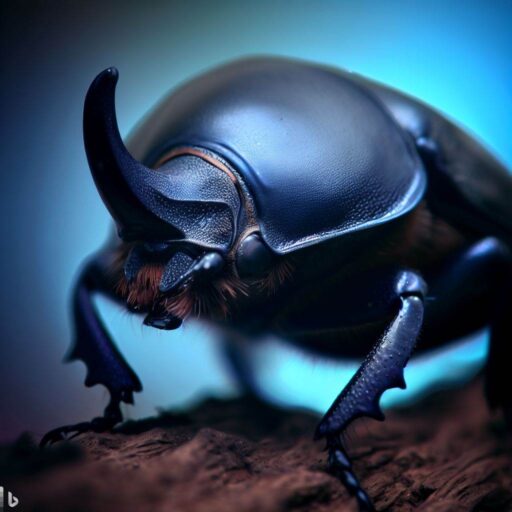.jpg)
- Japanese beetles have a diverse diet and feed on a wide range of plants, including roses, grapes, raspberries, linden trees, and many more.
- Feeding by Japanese beetles can cause significant damage to plants, leading to defoliation, decreased plant vigor, and even death in severe cases.
- To prevent and control Japanese beetle infestations, consider using trap plants, applying grub control fertilizer or nematodes, placing pheromone traps at garden borders, choosing less susceptible plants, and using Japanese beetle traps correctly.
Japanese beetles can wreak havoc on gardens and landscapes, decimating plants in their path.
In this section, we’ll provide an overview of these troublesome insects and delve into their voracious appetite, exploring the wide array of plants that fall victim to their destructive feeding habits.
Get ready to uncover the eating preferences of Japanese beetles, as we shed light on the impact these pests can have on our green spaces.
Overview of Japanese beetles and their diet

Japanese beetles are notorious for their ravenous appetite.
They eat leaves and flowers of many types of plants, inflicting major damage.
They are especially drawn to roses, grapes, linden trees, raspberries, and soybeans. Their feeding habits can lead to defoliation and stunted growth for the affected plants.
The consequences of Japanese beetle feeding are great.
Plants can’t photosynthesize or reproduce as well, reducing yields of agricultural crops and ruining the beauty of ornamental plants.
Furthermore, the chemical signals released during feeding often attract more beetles to the area.
To prevent and control Japanese beetle infestations, there are a few strategies.
Trap plants can draw the beetles away from desirable plants.
Grub control fertilizer and nematodes can target the larvae before they become adults.
Pheromone traps at the garden border can catch adult beetles.
It’s also important to choose to plant species less susceptible to Japanese beetle attacks.
However, if Japanese beetle traps are not used properly, the problem can worsen.
Plants that Japanese beetles eat

The Japanese beetle is notorious for munching on a great array of plants. This can create massive destruction to farmers’ and gardeners’ crops.
Being aware of their favored plants may assist in protecting their bounty. Here are a few of the plants that Japanese beetles typically feed on:
- Roses: Japanese beetles love the leaves of roses and can swiftly leave them bare if unchecked.
- Apples: These beetles relish the apple tree leaves, which can badly affect fruit production.
- Grapes: The leaves and fruits of grapevines are a favorite dish of Japanese beetles.
- Linden Trees: Japanese beetles are pulled to the foliage of linden trees, causing rapid leaf loss.
- Green Beans: They also target green bean plants, damaging both the leaves and beans.
Keep in mind, these are just some examples. They can also eat raspberries, plums, peaches, and hollyhocks.
Gardeners and farmers should be watchful for the presence of Japanese beetles and take necessary actions to manage their numbers and protect their plants.
Impact of Japanese beetle feeding on plants
Japanese beetles impact many plants. They eat leaves, flowers, and fruits, causing harm. According to data, they can feed on over 300 to plant species, including trees and crops.
This behavior leads to defoliation, decreased photosynthesis, and weakened health.
They skeletonize leaves by eating tissue between veins, making plants look lacy.
This damages the aesthetic appeal and growth of plants. Additionally, it attracts other pests and diseases, possibly causing death.
Moreover, they have a preference for certain plants, like roses, grapevines, linden trees, and raspberries.
This selective feeding can hurt the horticultural industry and home gardens.
It’s important to recognize Japanese beetles as not only harmful to plants, but also causing economic losses.
They damage corn and soybeans, resulting in reduced yields and quality, impacting farmers and agriculture.
Tips for preventing and controlling Japanese beetle infestations
When it comes to dealing with Japanese beetle infestations, prevention and control are key. In this section, we’ll explore a range of effective strategies to keep these pesky beetles at bay.
- Utilizing trap plants to attract and control Japanese beetles
- Applying grub control fertilizer or using nematodes to tackle grub populations
- Placing pheromone traps at garden borders
- Selecting plants less likely to attract Japanese beetles
- Tips on how to properly use Japanese beetle traps without worsening the problem
Using trap plants to attract and control Japanese beetles
Trap plants can be a great tool for managing Japanese beetles. They release chemicals that draw the insects in. Keep trap plants away from your desired plantings, and regularly monitor them to ensure effective beetle population control.
Using trap plants alone is not enough though. Combine them with other strategies such as applying grub control fertilizer or using nematodes for comprehensive control.
Integrating trap plants into your pest management plan can help minimize beetle damage and maintain the health and beauty of your garden. This approach targets the beetles without harming desirable plants.
Applying grub control fertilizer or using nematodes to control grub populations
Grub control fertilizer and nematodes are effective grub population management methods. Grubs, the larvae of certain beetles, can damage lawns and gardens as they feed on plant roots.
Fertilizer: This type of fertilizer contains insecticides which target grubs. When applied to soil, it kills grubs, stopping them from becoming adult beetles. Using it can reduce the number of grubs, thus decreasing the Japanese beetle food source.
Nematodes: Nematodes are small worms that eat insects, including grubs. When released into soil, they seek out grubs and release bacteria which kill them. This natural method is safe for the environment and a great way to control grub populations without harming beneficial insects or plants.
Combination: Combining both grub control fertilizer and nematodes is more effective in controlling grub populations. The fertilizer kills existing grubs, while the nematodes attack any hatching grubs.
Using either grub control fertilizer or nematodes helps prevent Japanese beetle infestations. It reduces the food source for adult beetles, discouraging them from targeting plants.
For safety and proper application, it is important to follow instructions carefully when using these products.
Pheromone traps can be placed at the garden border to catch and control adult beetles.
Placing pheromone traps at the border of a garden to catch and control adult beetles
Pheromone traps at the garden’s border can help capture and manage adult Japanese beetles. The traps emit a scent that lures the beetles away from plants. Then, they can be removed and disposed of.
- Position the traps along the garden’s perimeter at regular intervals.
- Also, make sure they are properly set up and maintained.
- Clean and replace traps as needed.
- Monitor the traps and remove captured beetles.
- If overcrowding occurs, add more traps or empty them more often.
By using pheromone traps, homeowners can reduce beetle feeding damage.
Monitor the traps, clean them, and adjust when necessary. Don’t rely solely on traps, though.
Include other strategies like choosing beetle-resistant plants or using nematodes or grub control fertilizer to target larvae for optimal results.
Choosing plants that are less susceptible to Japanese beetle attack
Choose plants that Japanese beetles don’t like! Woody plants like boxwood, arborvitae, and holly are great choices.
Herbaceous perennials such as hostas, peonies, and ferns are also less vulnerable.
Ornamental grasses like switchgrass and maiden grass are also good alternatives.
And, native to plant species often have built-in defenses against these pests.
Gardeners can use these strategies to decrease the risk of damage to their gardens.
Plant selection is key for maintaining a beautiful garden while limiting Japanese beetle feeding.
Stop Japanese beetles from ruining your garden! Use Japanese beetle traps for the best results.
Properly using Japanese beetle traps to avoid exacerbating the problem
Japanese beetle traps are a helpful way to handle infestations. But, it’s important to use them correctly to avoid making the situation worse. Here’s what to do:
- Place the trap at the edge of your garden, far away from plants. This will draw beetles away and protect plants.
- Follow the instructions on how many traps you need for the area. Too many can bring in more beetles and more damage.
- Check the traps often and take out any beetles. Doing this will keep the trap working.
- Put traps far away from plants. This stops accidental attraction of beetles to vegetation.
- Don’t rely on the traps alone. Use other strategies like picking plants beetles don’t eat, and using grub control fertilizer or nematodes.
- Dispose of trapped beetles far away from your garden. This stops pheromones from bringing pests back.
By using Japanese beetle traps correctly, gardeners can control beetle infestations.
Proper placement, regular emptying, and other pest control measures will keep Japanese beetles away and minimize damage.
Conclusion and final thoughts on managing Japanese beetles
Japanese beetles can be a real pain in the garden. They feed on plants like roses, grapes, raspberries and linden trees.
But there are plants they tend to avoid, such as lilacs, boxwood and forsythia.
To manage them, it helps to understand their feeding habits. They like plants that release certain compounds, like those from roses and grapes.
So, reducing these compounds in your garden can reduce their attraction. Additionally, planting garlic, chives or tansy can help keep them away.

Monitoring and early detection are key. Inspect your plants regularly for signs of infestation, like skeletonized leaves or groups of beetles.
If you spot them, handpick them off and drop them into a bucket of soapy water.
To protect your garden, it’s important to take action now.
Identify the plants Japanese beetles are attracted to and replace them with less attractive options.
Use natural repellents and monitor your plants. Don’t wait until it’s too late – take control and ensure the health of your garden.
Some Facts About What Plants Do Japanese Beetles Eat:
- ✅ Japanese beetles feed on over 300 to plant species, including roses, hibiscuses, grapes, raspberries, and various fruit trees.
- ✅ They also damage turfgrass by chewing on the roots, causing the turf to turn brown and die.
- ✅ Japanese beetles have a preference for softer-leaved plants, including flowers and fruits.
- ✅ Geraniums contain a compound that paralyzes Japanese beetles, making them a trap plant for eco-conscious gardeners. (Source: USDA)
- ✅ Some plants, like those with a pungent garlic or onion aroma and certain types of pines, are usually immune to Japanese beetle attack. (Source: USDA)
FAQ
What plants do Japanese beetles eat?
Japanese beetles are known to feed on over 300 species of plants.
Some of their preferred food sources include roses, hibiscuses, grapes, raspberries, sassafras, Norway maple, Japanese maple, black walnut, gray birch, American elm, and various flowering fruit trees such as grape, pear, plum, peach, and cherry.
How do Japanese beetles damage plants?
Japanese beetles feed in groups, starting at the top of the plant and working their way down.
They skeletonize leaves, causing them to turn brown and fall off. Feeding on fruits and flowers can also occur, leading to significant damage.
Injured plants emit an odor that attracts more beetles, exacerbating the problem. Young or unhealthy plants may be stunted or killed by their feeding.
Are there any plants that Japanese beetles avoid?
Plants with a pungent garlic or onion aroma, as well as pine trees, are usually immune to Japanese beetle attacks. There are also some cultivars of fruits that are hardier against attack than others.
How do Japanese beetles impact lawns and turfgrass?
The larvae of Japanese beetles, known as white grubs, damage turfgrass by chewing on the roots. This can lead to dead patches that can be easily rolled up. Managing white grubs is important for protecting lawns from damage.
How can I control Japanese beetles?
There are both nonchemical and insecticide options for managing Japanese beetles.
Nonchemical management strategies include physical removal of beetles, using physical barriers, and choosing less preferred plants.
If these methods are not practical or effective, insecticides can be used to protect plants. It is important to use low-risk insecticides that are not toxic to beneficial insects and to follow label instructions.
What is the life cycle of Japanese beetles?
The life cycle of Japanese beetles begins with eggs that are laid in the soil during the summer.
These eggs develop into grubs, which spend the fall and winter months feeding on the roots of lawns and plants.
In spring, the grubs move closer to the surface, lightly feeding on plant roots before pupating.
Adult beetles start emerging in mid-June and feed on plant foliage, stems, corn silk, and fruits until August.





Leave a Reply